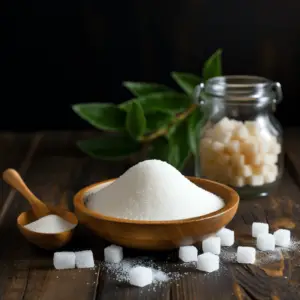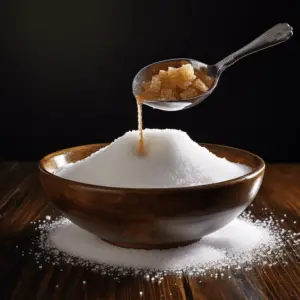Invert sugar, invert syrup or inverted sugar is an artificial sweetener commonly used by professional bakers and confectioners and is the preferred option to table sugar for a number of reasons.
The most common reason for using inverted sugar in place of common sugar is crystallization. If you are a professional baker or a baking enthusiast you have likely come across this problem where your pastries contain a crunchy quality which is not an intentional artifact of the baking process.
If anything, it interferes with the intended evenness, smoothness, and moist texture of your pastries. This is caused by the use of table sugar in baking since table sugar tends to crystalize back into granulated form solidifying along with moisture or water molecules in your cake.
Professional bakers use invert sugar instead, to counteract this problem. If you do not have it though, there are a few products you can use in place of invert sugar. So, what is invert sugar?
Table of Contents
What is invert sugar?

Invert sugar is a sweet viscous sucrose-based fluid that is a mixture of two monosaccharides, fructose, and glucose. Table sugar or sucrose is a granulated disaccharide or a compound of fructose and glucose.
To put it simply, in inverted sugar, the fructose and glucose which are pure sugars are not chemically bonded while in table sugar the fructose and glucose are chemically bonded.
When fructose and glucose are merely a mixture in water, the mixture presents as a thick liquid and when bonded, the compound presents as a granulated solid.
Invert sugar is made by breaking down the disaccharide that makes table sugar into its constituent monosaccharides, fructose, and glucose through hydrolysis. Hydrolysis is the broad term for any process of using water to break chemical bonds.
In this case, water is used alongside an acid to break table sugar down into inverted syrup.
Before considering a substitute for inverted sugar, below are the reasons for using invert sugar over other sweeteners:
- It is sweeter. Compared to table sugar invert sugar is much sweeter and using it can cut the cost of sugar by nearly 40%.
- It has a longer shelf life than normal sugar and this effect extends to the shelf life of pastries making it the better option for commercial baking and confectionery.
- It retains moisture without solidifying thus yielding moist, smoother, and softer pastries.
- It does not crystallize even when refrigerated. This means it can be used in delicate confectioneries that need to retain their consistencies such as ice cream, sorbets, chocolate, ganache, toffee, sweets, fondant, icing, and fudge among others.
- It enhances the browning of foods when cooking by boosting the Maillard reaction giving the final product an even and beautifully earthy color.
- It dissolves in cold liquids readily making it ideal in cocktails and iced tea.
Invert Sugar Substitutes
In place of invert sugar some of the substitutes you can use include:
Liquid honey
Invert sugars gives foods excellent texture and consistency. Honey does the same. Essentially, they are very similar.
Honey is in large part invert sugar which is evident from its viscous fluid presentation but it also contains other organic compounds that make it a more complex substance.
In terms of sweetness and consistency, you may substitute invert sugars with honey but in terms of flavor, honey is certainly superior to invert sugar.
Honey has more aroma and herbal touches to its flavor that invert sugars lacks. If you are going for strict and uniform taste across the board in your pastries you are better served by invert sugar which allows you full control over the eventual flavor of your pastries.
If you want room for more flavor and varying texture, honey is better since each brand brings different qualities and as such varying flavors.
Corn syrup
Corn syrup is made when corn cobs are processed to produce syrup. This syrup is an excellent substitute for invert sugars, particularly for softer and tender pastries.
It is also excellent for making more subtle and subdued flavors due to its significantly lower intensity in sweetness compared to invert sugars.
Brown sugar
Brown sugar is table sugar with an amount of invert sugar’s in it though not enough to alter its form to a syrup.
In most instances where brown sugar is used, the aim is the color and flavor over the consistency.
Cakes made using brown sugar are distinctly flavorful compared to those made with table sugar and the color is a stunning dark cream to brown which enhances its appearance.
Brown sugar is not the best option for ganache or brioche which need even consistency even in refrigerator conditions.
Molasses
This is a by-product of processing sugar beets and sugar cane. This dark viscous fluid makes pastries distinctly rich in flavor and thicker.
Molasses settles well in pastries and does not crystallize. It however oxidizes quite fast making it a poor choice for commercial baking since baked goods will easily go bad after a short time.
Molasses is also not a favorite of many considering its complex flavor profile and using it is the preserve of a few.
Glucose syrup or Confectioner’s syrup

As the name suggests, this is a syrup made from the hydrolysis of starch to extract glucose. If the starch is corn then it will be corn syrup but more commonly what is labeled glucose syrup is often made from potatoes, wheat, rice, and cassava.
It is often mixed with other monosaccharides such that the syrup contains about 40% glucose. It can be used in place of invert sugar and is often used to thicken mixtures and add volume to confectionery.
Golden syrup
Golden syrup is a mixture of approximately 55% invert sugar and 45% table sugar. It can also be used to replace invert sugar to encourage some of the evenness that invert sugar creates in pastries.
Finally…
Invert sugar is not a healthier option than table sugar and the calorie or sugar content could be similar if not higher than that of table sugar.
